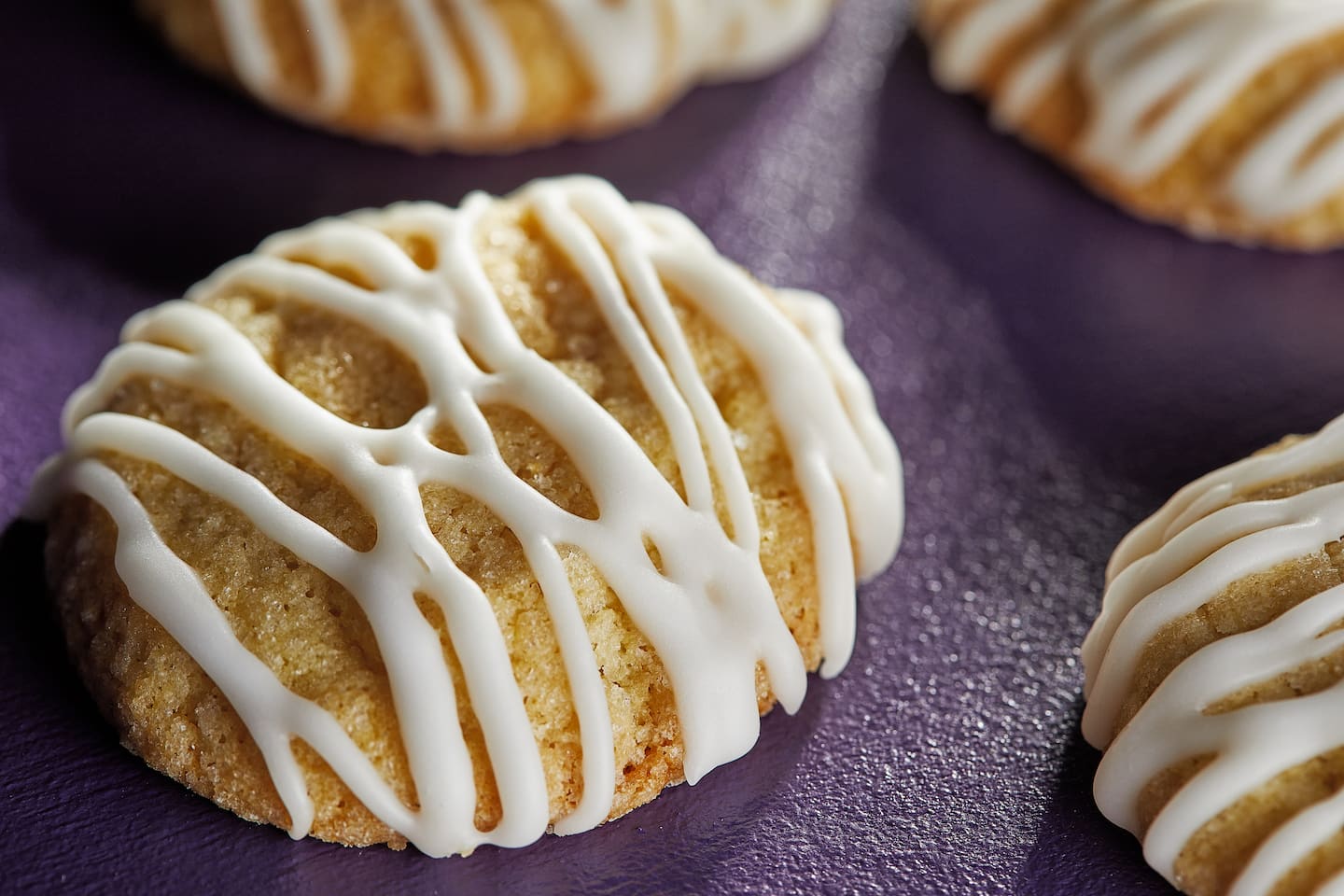If you’re craving a lemon cookie that actually tastes like lemon, this is it

I first beat the zest with the sugars; the sugar crystals act like shards, cutting through the zest and expelling their fragrant lemony oils. To add subtle tangy and creamy notes, I added a little cream cheese. Finally, I didn’t want to waste the lemon juice, so I decided to make a simple icing. The brothers loved it.
However, my results were inconsistent. Sometimes the lemon flavor was weak or the cookies came out too doughy. Revisiting this recipe, I’ve added lemon extract to fortify the lemon flavor, I bake them smaller and at higher temperature, and I coat them with sugar to create a crispy exterior. I also dip them in a very thin and tangy glaze. The result is crispy, buttery, tangy — and, perhaps most important, lemony.
Recipe note: The cookies can be stored in an airtight container for up to 3 days at room temperature and frozen for up to 1 month.
Ingredients
For the cookies
- 2 cups (400 grams) granulated sugar, divided
- 1/4 cup (15 grams) lemon zest (from about 4 medium lemons)
- 16 tablespoons (2 sticks/225 grams) unsalted butter, at room temperature
- 4 ounces (110 grams) cream cheese, at room temperature
- 3 tablespoons (40 grams) packed light brown sugar
- 1 1/2 teaspoons cornstarch
- 1 teaspoon fine sea salt
- 3/4 teaspoon baking soda
- 2 large eggs, at room temperature
- 1 tablespoon lemon extract
- 2 drops yellow food gel coloring (optional)
- 3 cups (375 grams) all-purpose flour
For the icing
- 3 cups (375 grams) confectioners’ sugar, plus more as needed
- 1/4 teaspoon fine sea salt
- 1/3 cup (80 milliliters) fresh lemon juice (from about 3 lemons)
Step 1
Make the cookies: Position a rack in the middle of the oven and preheat to 400 degrees. Line at least two large, rimmed baking sheets with parchment paper.
Step 2
In a stand mixer fitted with the paddle attachment, or using a large bowl and a hand mixer, beat 1 1/4 cups (250 grams) granulated sugar and lemon zest on medium speed until very fragrant, about 2 minutes. Add the butter, cream cheese, brown sugar, cornstarch, salt and baking soda. Beat on medium until thoroughly combined, about 2 minutes, then scrape down the sides of the bowl. Beat for an additional 30 seconds on medium.
Step 3
In a liquid measuring cup, whisk the eggs and pour in a stream down the side of the mixer bowl while beating on medium speed. Scrape down the sides of the bowl, add the lemon extract and food coloring, if using, and beat again on medium for about 30 seconds, then scrape down the bowl again. Add the flour and mix on low speed until it is no longer visible and the mixture is homogenous. Give it a few turns with a flexible spatula to make sure there is no dry flour left. Transfer the bowl to the refrigerator and let the dough chill for at least 30 minutes (it’s quite sticky and is much easier to roll when cold).
Step 4
Place 3/4 cup (150 grams) granulated sugar in a bowl or shallow dish for rolling. Using a No. 60 disher or measuring spoon, scoop the dough into 1-tablespoon portions (about 20 grams each), shape into a smooth ball with your fingers and gently roll them in the granulated sugar until evenly coated. Transfer to the lined baking sheets, spacing the balls about 2 inches apart.
Step 5
Bake one sheet at a time for 8 to 10 minutes. The cookies should be brown along the edges, puffed and golden on top and have cracks all over. Using the bottom of a measuring cup, gently flatten the cookies to about 1/2-inch thickness. Let cool on the baking sheets for 10 minutes, then transfer to a wire rack to cool completely.
Repeat with the remaining dough, letting each baking sheet cool completely before reusing. You may also run the sheets under cool water and dry to speed up the process.
Step 6
Make the icing: While the cookies are cooling, sift the confectioners’ sugar into a large bowl and whisk in the salt. Pour the lemon juice in a stream down the side of the bowl and gradually start working it into the sugar with a whisk. The icing should be loose and very tangy. You may add more confectioners’ sugar if you prefer a thicker icing.
Step 7
You have a few options for applying the icing. Dip half the cookie into the icing, then use a small offset spatula or the flat side of a dinner knife to scrape the bottom of any excess. You also can pour the glaze over the top of cookies sitting on a wire rack set over a baking sheet, scraping off the excess. Or simply drizzle using a spoon or by filling a zip-top bag and cutting off the corner to create a makeshift piping bag. Allow the glaze to set, about 10 minutes.
Nutrition Information
Calories: 133; Total Fat: 5 g; Saturated Fat: 3 g; Cholesterol: 19 mg; Sodium: 88 mg; Carbohydrates: 22 g; Dietary Fiber: 0 g; Sugar: 16 g; Protein: 1 g.
Adapted from Washington friar Brother Andrew Corriente, past winner of “The Great American Baking Show.”
Scale and get a printer-friendly, desktop version of the recipe here.






